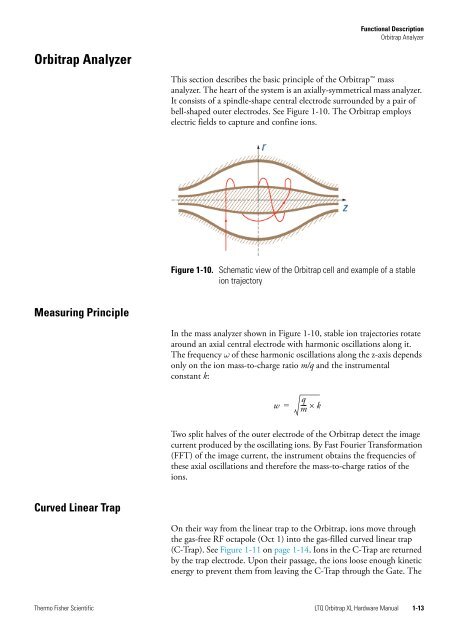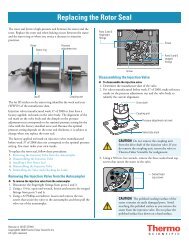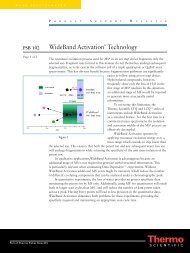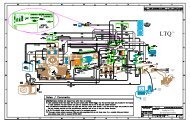LTQ Orbitrap XL Hardware Manual
LTQ Orbitrap XL Hardware Manual
LTQ Orbitrap XL Hardware Manual
You also want an ePaper? Increase the reach of your titles
YUMPU automatically turns print PDFs into web optimized ePapers that Google loves.
<strong>Orbitrap</strong> Analyzer<br />
Measuring Principle<br />
Curved Linear Trap<br />
Functional Description<br />
<strong>Orbitrap</strong> Analyzer<br />
This section describes the basic principle of the <strong>Orbitrap</strong> mass<br />
analyzer. The heart of the system is an axially-symmetrical mass analyzer.<br />
It consists of a spindle-shape central electrode surrounded by a pair of<br />
bell-shaped outer electrodes. See Figure 1-10. The <strong>Orbitrap</strong> employs<br />
electric fields to capture and confine ions.<br />
Figure 1-10. Schematic view of the <strong>Orbitrap</strong> cell and example of a stable<br />
ion trajectory<br />
In the mass analyzer shown in Figure 1-10, stable ion trajectories rotate<br />
around an axial central electrode with harmonic oscillations along it.<br />
The frequency ω of these harmonic oscillations along the z-axis depends<br />
only on the ion mass-to-charge ratio m/q and the instrumental<br />
constant k:<br />
Thermo Fisher Scientific <strong>LTQ</strong> <strong>Orbitrap</strong> <strong>XL</strong> <strong>Hardware</strong> <strong>Manual</strong> 1-13<br />
w<br />
=<br />
q<br />
m<br />
--- × k<br />
Two split halves of the outer electrode of the <strong>Orbitrap</strong> detect the image<br />
current produced by the oscillating ions. By Fast Fourier Transformation<br />
(FFT) of the image current, the instrument obtains the frequencies of<br />
these axial oscillations and therefore the mass-to-charge ratios of the<br />
ions.<br />
On their way from the linear trap to the <strong>Orbitrap</strong>, ions move through<br />
the gas-free RF octapole (Oct 1) into the gas-filled curved linear trap<br />
(C-Trap). See Figure 1-11 on page 1-14. Ions in the C-Trap are returned<br />
by the trap electrode. Upon their passage, the ions loose enough kinetic<br />
energy to prevent them from leaving the C-Trap through the Gate. The

















